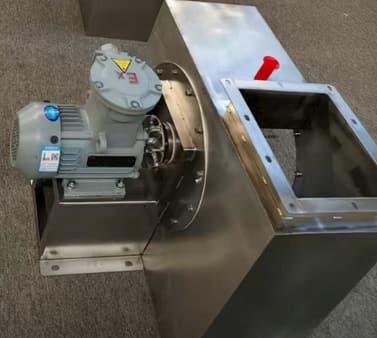Duct Fans: Types and Differences from Non-Ducted Fans
In modern HVAC systems and industrial ventilation applications, the duct fan plays a vital role in ensuring efficient air movement across connected spaces. Unlike standalone fans that discharge air freely into the surrounding environment, duct fans are specifically designed to work in conjunction with air ducts—rigid or flexible conduits that guide airflow from one point to another. This structural integration is the defining feature of duct fans, and it shapes their design, installation, and performance expectations.
What Is a Duct Fan?
A duct fan, also called an in-line duct fan or ducted ventilation fan, is engineered to push or pull air through ventilation ducts. These fans are commonly installed within HVAC systems, underground utility tunnels, subway ventilation shafts, or industrial air handling networks. The ability to maintain consistent airflow despite duct pressure loss makes duct fans indispensable in controlled air environments.
Their performance is closely tied to static pressure, airflow resistance, and duct geometry—factors that don't significantly affect free-discharging fans.
Common Types of Duct Fans
Depending on the airflow direction and pressure requirements, duct fans come in several designs:
1. Centrifugal Duct Fan
Centrifugal fans use a rotating impeller to increase the velocity of air before discharging it at a 90° angle. This makes them highly suitable for longer duct runs with higher static pressure. They are typically enclosed in rectangular or cylindrical housings.
Application: Ideal for commercial high-rise buildings and smoke extraction systems.
2. Axial Duct Fan
Axial duct fans move air along the axis of rotation, providing high flow rates with relatively lower pressure. When integrated with ducts, they must be sized appropriately to maintain efficiency.
Application: Best for low-resistance duct runs such as factories, parking garages.
3. Mixed Flow Duct Fan
A hybrid between axial and centrifugal, mixed flow duct fans combine high airflow and moderate pressure capability. They are compact yet powerful, often used in HVAC systems where space and performance are both critical.
Application: Widely used in HVAC cabinets, factories, high-rise buildings, ventilation risers.
Duct Connection Methods for Duct Fans
An essential feature of a duct fan is how it interfaces with the duct network. Here are some main connection types used in industrial and commercial applications:
1. Flanged Connection
Flanged ends are common in both circular and rectangular duct fans. Bolted flange rings allow for secure, leak-proof integration with corresponding duct flanges.
Advantage: High strength, suitable for high-pressure systems, and easy maintenance.
2. Flexible Connector
These connectors use a flexible, vibration-dampening fabric or rubber segment between the duct fan and the duct. It compensates for minor misalignments and reduces vibration transmission.
Advantage: Ideal for reducing noise and protecting ductwork from mechanical stress.
3. Slip-Fit or Duct Collar Connection
Often used in residential or small-scale HVAC systems, slip-fit connections allow duct ends to slide over the fan inlet or outlet and be sealed using clamps or foil tape.
Advantage: Quick and cost-effective for light-duty installations.
4. Custom Integrated Housing
For cabinet-style duct fans or modular air handling units, fans may be factory-mounted inside enclosures with preconfigured duct ports.
Advantage: Optimized airflow path, cleaner appearance, reduced on-site labor.
Differences Between Duct Fans and Non-Ducted Fans
Feature | Duct Fan | Non-Ducted Fan |
|---|---|---|
| Airflow Path | Through ducts | Directly to/from open space |
| Installation | In-line with ductwork | Wall-mounted, ceiling-mounted, or freestanding |
| Static Pressure Capability | High to moderate | Low |
| Design Focus | Efficiency under resistance | Free air performance |
| Use Case | HVAC, tunnels, fire ventilation | Spot cooling, air circulation |
Why Duct Fans Are Critical in Building Ventilation Systems
Duct fans are more than just airflow boosters—they are central components of balanced, efficient, and safe building ventilation. Their ability to distribute conditioned air, remove harmful fumes, and pressurize escape routes in emergencies makes them indispensable in:
-
High-rise buildings with centralized HVAC
-
Underground ventilation
-
High-rise towers with vertical duct risers
-
Industrial plants requiring dust or gas removal
Correctly sizing and installing duct fans ensures optimal performance, noise control, and energy efficiency. Poor duct design, mismatched fan selection, or improper sealing can lead to pressure loss, energy waste, or regulatory non-compliance.
Conclusion
A duct fan is more than just a fan inside a tube—it's a purpose-built solution for integrated airflow management. From centrifugal models handling long duct runs to axial or mixed-flow designs optimizing efficiency in compact installations, duct fans are indispensable to modern ventilation strategies. Their connection methods, pressure capabilities, and system integration all reflect a balance between airflow delivery and energy-conscious design.
For manufacturers like Zhejiang Shuangyang Fans Holding Co., Ltd, providing high-performance duct fans is key to enabling safe, comfortable, and regulatory compliant environments. Whether your project is a factory floor, tunnel shaft, or HVAC system, duct fans ensure that air gets to where it needs to be—quietly, efficiently, and reliably.
Note: The content of the article cannot avoid omissions and errors. Welcome to propose corrections.
 Mancooler (Workstation) Fans — Why Your Factory Needs the Right One
Mancooler (Workstation) Fans — Why Your Factory Needs the Right One
 Motor Classifications in Industrial Fans
Motor Classifications in Industrial Fans
 Materials for Explosion-Proof Fan
Materials for Explosion-Proof Fan
 Direct Drive vs. Belt Drive in Axial Fan and Centrifugal Fan
Direct Drive vs. Belt Drive in Axial Fan and Centrifugal Fan

